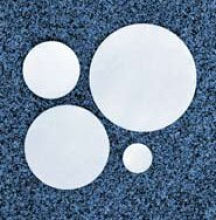Frequently Asked Questions About Membrane Filters

As a leading manufacturer and marketer of membrane filters, Sterlitech fields a lot of burning questions about membrane filtration for our customers. In this article, we tackle some of the most frequently asked questions we receive about the basics of membrane filtration. If you have a question that isn’t covered below, be sure to let us know here. Q: What is the difference between hydrophilic vs hydrophobic membranes?A: Hydrophilic filters posses an affinity for water and can be wetted with almost any liquid. Sterlitech carries a wide variety of hydrophilic membranes, including:
- Silver Metal
- Polyethersulfone (PES)
- Glass Fiber
- Polycarbonate Track Etch (PCTE)
- Polyester (PETE)
- Mixed Cellulose Esters (MCE)
- Nylon
- Cellulose Acetate
Hydrophobic filters are just the opposite; they lack an affinity for water and are best suited for venting applications. Examples of hydrophobic filters include Sterlitech polypropylene membranes and Sterlitech PTFE filters, which are either laminated or unlaminated. Q: How is the performance of a filter measured? A: Design and material selection determines the performance of a filter. Three important measures of filter performance are flow rate, throughput, and the bubble point, and are defined as follows: Flow Rate: Describes the volume of liquid or air that will flow through the filter at a fixed pressure and temperature. This is usually measured as mL/minute or cm^2/minute. Throughput: Describes the dirt handling capacity of a filter. Namely, how long the liquid will continue to flow through the membrane before the membrane clogs. The lower the flow rate and throughput, the longer it takes the researcher to complete the analysis. Bubble Point: The bubble point is the differential pressure at which a steady stream of gas bubbles is emitted from a wetted filter under specific test conditions. Testing the bubble point helps determine the integrity and pore size of a filter. The bubble point test measures the largest pore. Bubble point is generally determined using water or an alcohol (methanol or isopropynol) and is displayed as PSI. Q: What variables affect the performance of a filter? A: Viscosity: The viscosity of a liquid determines its resistance to flow; the higher the viscosity, the lower the flow rate and the higher the differential pressure required to achieve a given flow rate. Porosity: The flow rate of a membrane is directly proportional to the porosity of a membrane, eg. the more pores, the higher the flow rate. Filter Area: The larger the filter area, the faster the flow rate at a given pressure differential and the larger the expected filter throughput volume prior to "clogging for a given solution." Q: How are pore sizes rated? A: A pore size rating is determined by the diameter of the particle that it can be expected to retain with a defined, high degree of efficiency. The rating is stated innominal or absolute terms. Q: How is pore size determined? A: The pore size of a filter, normally stated in micrometers (µm), is determined by the diameter of a particle that is retained by the filter. This is determined using a challenge organism and/or bubble point testing. Q: What is the difference between nominal and absolute pore size ratings? A: Nominal pore size rating describes the ability of the filter to retain the majority of the particles at the rated pore size and larger (60-9%). Glass fiber filters and screen filters are a good example of nominally rated filtration. Absolute size rating describes the pore size at which a challenge organism of a particular size will be retained with 99.9% efficiency under strictly defined test conditions. Most membrane filters are rated as absolute terms. Q: What organisms are used to determine pore size?A:
| Pore Size | Challenge Organism |
| 0.1 µm | Acholeplasma laidlawii |
| 0.2 µm | Brevundimonas diminuta |
| 0.45 µm | Serratia marcescens |
| 0.8 µm | Lactobacillus species |
| 1 µm | Candida albicans |
- Most Viewed Blog Articles (5)
- Company News (285)
- Emerging Technologies (64)
- Microbiology and Life Science News (93)
- Water and Fluid Separation News (97)
- Filtration Resources (93)
- Product News (19)


![Join Sterlitech at BIO 2024 [Booth #5558]: Exploring the Future of Biotechnology](https://www.sterlitech.com/media/blog/cache/300x200/magefan_blog/b4.jpeg)



